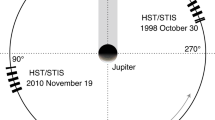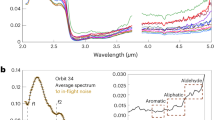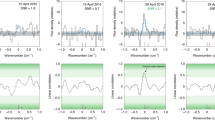Abstract
Europa’s surface continuously experiences high fluxes of charged particles due to the presence of Jupiter’s strong magnetic field. These high-energy charged particles, including electrons, interact with the ice- and salt-rich surface, resulting in complex physical and chemical processes. Here, we report that Europa ice analogues emit characteristic spectral signatures in the visible region when exposed to high-energy electron radiation. The strongest emission (ice glow) we observed was centred at ~525 nm. We found that the presence of sodium chloride and carbonate strongly quenched, while epsomite enhanced, the radiation-induced ice glow. These emission characteristics could be used to determine the chemical composition of Europa’s surface during night-time low-altitude fly-bys of spacecraft such as the Europa Clipper. We estimate that the Europa Clipper Wide Angle Camera could record between 500 and 280,000 counts per second through different colour filters, depending on the chemical composition of Europa’s surface. Though we focus here on Europa, our study may be relevant to other bodies exposed to high doses of ionizing radiation, such as Io and Ganymede. With its extreme radiation environment, rich surface geology and compositional diversity, the radiation-induced ice glow on Europa could enable more precise surface characterization and provide unique night-time views.
This is a preview of subscription content, access via your institution
Access options
Access Nature and 54 other Nature Portfolio journals
Get Nature+, our best-value online-access subscription
$29.99 / 30 days
cancel any time
Subscribe to this journal
Receive 12 digital issues and online access to articles
$119.00 per year
only $9.92 per issue
Buy this article
- Purchase on Springer Link
- Instant access to full article PDF
Prices may be subject to local taxes which are calculated during checkout





Similar content being viewed by others
Data availability
The data that support the figures and table within this paper and other findings of this study are available from the corresponding author upon reasonable request. Source data are provided with this paper.
Change history
15 June 2021
Editor's Note: The authors have informed the editors of Nature Astronomy about an error in converting the laboratory electron simulated emission data to the number of photons reaching the Wide Angle Camera pixels. The authors are working to better quantify those numbers, but in the meantime, readers are cautioned against using the paper’s estimate. Interested readers may contact the corresponding author for further information.
References
Clark, K. et al. Return to Europa: overview of the Jupiter Europa orbiter mission. Adv. Space Res. 48, 629–650 (2011).
Hand, K. P., Carlson, R. W. & Chyba, C. F. Energy, chemical disequilibrium, and geological constraints on Europa. Astrobiology 7, 1006–1022 (2007).
Pappalardo, R. T. et al. Does Europa have a subsurface ocean? Evaluation of the geological evidence. J. Geophys. Res. 104, 24015–24055 (1999).
Pappalardo, R. T., McKinnon, W. B. & Khurana, K. (eds) Europa (Univ. of Arizona Press, 2009).
Pappalardo, R. T. et al. Science potential from a Europa lander. Astrobiology 13, 740–773 (2013).
Nordheim, T. A., Hand, K. P. & Paranicas, C. Preservation of potential biosignatures in the shallow subsurface of Europa. Nat. Astron. 2, 673–679 (2018).
Patterson, G. W., Paranicas, C. & Prockter, L. M. Characterizing electron bombardment of Europa’s surface by location and depth. Icarus 220, 286–290 (2012).
Dalton, J. III et al. Exogenic controls on sulfuric acid hydrate production at the surface of Europa. Planet. Space Sci. 77, 45–63 (2013).
Fanale, F. P. et al. Tyre and Pwyll: Galileo orbital remote sensing of mineralogy versus morphology at two selected sites on Europa. J. Geophys. Res. Planets 105, 22647–22655 (2000).
Hanley, J., Chevrier, V. F., Barrows, R. S., Swaffer, C. & Altheide, T. S. Near- and mid-infrared reflectance spectra of hydrated oxychlorine salts with implications for Mars. J. Geophys. Res. Planets 120, 1415–1426 (2015).
Hanley, J., Dalton, J. B., Chevrier, V. F., Jamieson, C. S. & Barrows, R. S. Reflectance spectra of hydrated chlorine salts: the effect of temperature with implications for Europa. J. Geophys. Res. Planets 119, 2370–2377 (2014).
Ligier, N., Poulet, F., Carter, J., Brunetto, R. & Gourgeot, F. VLT/SINFONI observations of Europa: new insights into the surface composition. Astron. J. 151, 163 (2016).
Shirley, J. H., Dalton, J. B., Prockter, L. M. & Kamp, L. W. Europa’s ridged plains and smooth low albedo plains: distinctive compositions and compositional gradients at the leading side-trailing side boundary. Icarus 210, 358–384 (2010).
Sparks, W. B. et al. Hubble Space Telescope observations of Europa in and out of eclipse. Int. J. Astrobiol. 9, 265–271 (2010).
de Kleer, K. & Brown, M. E. Europa’s optical aurora. Astron. J. 156, 167 (2018).
Roth, L. et al. Europa’s far ultraviolet oxygen aurora from a comprehensive set of HST observations. J. Geophys. Res. Space Phys. 121, 2143–2170 (2016).
Grossweiner, L. I. & Matheson, M. S. Fluorescence and thermoluminescence of ice. J. Chem. Phys. 22, 1514–1526 (1954).
Nash, D. B., Matson, D. L., Johnson, T. V. & Fanale, F. P. Na-D line emission from rock specimens by proton bombardment: implications for emissions from Jupiter’s satellite Io. J. Geophys. Res. 80, 1875–1879 (1975).
Nelson, R. M. & Nash, D. B. Spectral reflectance change and luminescence of selected salts during 2–10 KeV proton bombardment: implications for Io. Icarus 39, 277–285 (1979).
Buxton, G. V., Gillis, H. A. & Klassen, N. V. Two types of localized excess electrons in crystalline D2O ice. Can. J. Chem. 55, 2385–2395 (1977).
Sitharamarao, D. & Duncan, J. Molecular excitation of water by γ-irradiation. J. Phys. Chem. 67, 2126–2132 (1963).
Miyazaki, T., Kamiya, Y., Fueki, K. & Yasui, M. New band of emission from high-energy-electron-irradiated ice at very low temperature. J. Phys. Chem. 96, 9558–9561 (1992).
Henderson, B. L., Gudipati, M. S. & Bateman, F. B. Leeb hardness of salty Europa ice analogs exposed to high-energy electrons. Icarus 322, 114–120 (2019).
Grossweiner, L. I. & Matheson, M. S. Luminescence of ice and tritiated ice. J. Chem. Phys. 20, 1654–1655 (1952).
Ghormley, J. A. Luminescence of ice subjected to ionizing radiation. J. Chem. Phys. 24, 1111–1112 (1956).
Steen, H. B. Radioluminescence of H2O and D2O ice spectral characteristics. Chem. Phys. Lett. 35, 508–510 (1975).
Petrik, N. G. & Kimmel, G. A. Low-energy electron-stimulated luminescence of thin H2O and D2O layers on Pt(111). J. Phys. Chem. B 109, 15835–15841 (2005).
Kimmel, G. A., Orlando, T. M., Cloutier, P. & Sanche, L. Low-energy (5–40 eV) electron-stimulated desorption of atomic hydrogen and metastable emission from amorphous ice. J. Phys. Chem. B 101, 6301–6303 (1997).
Quickenden, T. I., Trotman, S. M. & Sangster, D. F. Pulse radiolytic studies of the ultraviolet and visible emissions from purified H2O ice. J. Chem. Phys. 77, 3790–3802 (1982).
Miyazaki, T., Nagasaka, S., Kamiya, Y. & Tanimura, K. Formation of excited hydroxyl radicals in high-energy-electron-irradiated ice at very low temperature. J. Phys. Chem. 97, 10715–10719 (1993).
Matich, A. J., Bakker, M. G., Lennon, D., Quickenden, T. I. & Freeman, C. G. Oxygen luminescence from UV-excited (H2O and D2O) ices. J. Phys. Chem. 97, 10539–10553 (1993).
Gudipati, M. S. & Kalb, M. Rydberg and charge-transfer states of atomic oxygen in Ar and Kr matrices: identification of two distinct sites. Chem. Phys. Lett. 307, 27–34 (1999).
Park, S. H., Hyun, J. Y. & Shin, I. A lysosomal chloride ion-selective fluorescent probe for biological applications. Chem. Sci. 10, 56–66 (2019).
Takeuchi, T. & Sumida, J. Indirect detection of halide ions via fluorescence quenching of quinine sulfate in microcolumn ion chromatography. Anal. Sci. 20, 983–985 (2004).
Ryan, K. J., Pool, J., Lovelady, H. & Osterman, S. N. Design, fabrication, and test of a patterned optical filter array for the Europa Imaging System (EIS). Proc. SPIE 10706, 1070655 (2018).
Turtle, E. et al. The Europa Imaging System (EIS): high-resolution, 3-D insight into Europa’s geology, ice shell, and potential for current activity. EPSC Abstracts 13, EPSC-DPS2019-832-2 (2019).
Paranicas, C., Cooper, J. F., Garrett, H. B., Johnson, R. E. & Sturner, S. J. in Europa (eds Pappalardo, R. T. et al.) 529–544 (Univ. of Arizona Press, 2009).
Cooper, J. F., Johnson, R. E., Mauk, B. H., Garrett, H. B. & Gehrels, N. Energetic ion and electron irradiation of the icy Galilean satellites. Icarus 149, 133–159 (2001).
Jun, I., Garrett, H. B., Swimm, R., Evans, R. W. & Clough, G. Statistics of the variations of the high-energy electron population between 7 and 28 jovian radii as measured by the Galileo spacecraft. Icarus 178, 386–394 (2005).
Hirano, Y. & Yamamoto, S. Estimation of the fractions of luminescence of water at higher energy than Cerenkov-light threshold for various types of radiation. J. Biomed. Opt. 24, 066005 (2019).
Cessateur, G., Barthelemy, M. & Peinke, I. Photochemistry-emission coupled model for Europa and Ganymede. J. Space Weather Space Clim. 6, A17 (2016).
Zappala, G. et al. Set-up and methods for SiPM Photo-Detection Efficiency measurements. J. Instrum. 11, P08014 (2016).
Janesick, J. et al. Mk x Nk gated CMOS imager. SPIE Opt. Eng. Appl. 9211, 921106 (2014).
Gallina, G. et al. Characterization of SiPM avalanche triggering probabilities. IEEE Trans. Electron Dev. 66, 4228–4234 (2019).
Hsieh, C. A., Tsai, C. M., Tsui, B. Y., Hsiao, B. J. & Lin, S. D. Photon-detection-probability simulation method for CMOS single-photon avalanche diodes. Sensors 20, 436 (2020).
Acknowledgements
This work was supported by JPL’s internal R&TD funds as well as funding from NASA Solar System Workings and Habitable Worlds Programs. Experiments were performed at the NIST and data analysed at JPL. This work was conducted by the Jet Propulsion Laboratory, California Institute of Technology under a contract with NASA. Certain commercial equipment is identified in this paper to adequately describe the experimental procedure. Such identification does not imply recommendation or endorsement by the National Institute of Standards and Technology or the Jet Propulsion Laboratory, California Institute of Technology.
Author information
Authors and Affiliations
Contributions
M.S.G. conceived the idea. M.S.G. and B.L.H. conducted the experimental work at NIST. B.L.H. and M.S.G. conducted the data analysis. M.S.G. and B.L.H. wrote the manuscript. F.B.B. provided experimental support, beam operations and monitoring of the electron flux.
Corresponding author
Ethics declarations
Competing interests
The authors declare no competing interests.
Additional information
Peer review information Nature Astronomy thanks Timothy Cassidy and Anna Pollmann for their contribution to the peer review of this work.
Publisher’s note Springer Nature remains neutral with regard to jurisdictional claims in published maps and institutional affiliations.
Extended data
Extended Data Fig. 1 An example of an original raw emission spectrum (red line) showing spikes caused by the high-energy MeV electron radiation environment in spite of shielding by lead bricks.
These spikes are effectively removed by percentile filter option in the Origin Labs plotting program. Processed spectrum is shown below the raw spectrum (black line). Spectra are displaced along y-axis for visibility.
Supplementary information
Supplementary Data 1
Describes computational steps to convert lab data into counts per second at the WAC, estimates of aurorae counts.
Source data
Source Data Fig. 2
Raw data, normalization, smoothing and calibrations.
Source Data Fig. 3
Ascii data.
Source Data Fig. 4
Raw data, normalization, smoothing and calibrations.
Source Data Fig. 5
Ascii data.
Source Data Extended Data Fig. 1
Ascii data.
Rights and permissions
About this article
Cite this article
Gudipati, M.S., Henderson, B.L. & Bateman, F.B. Laboratory predictions for the night-side surface ice glow of Europa. Nat Astron 5, 276–282 (2021). https://doi.org/10.1038/s41550-020-01248-1
Received:
Accepted:
Published:
Issue Date:
DOI: https://doi.org/10.1038/s41550-020-01248-1



